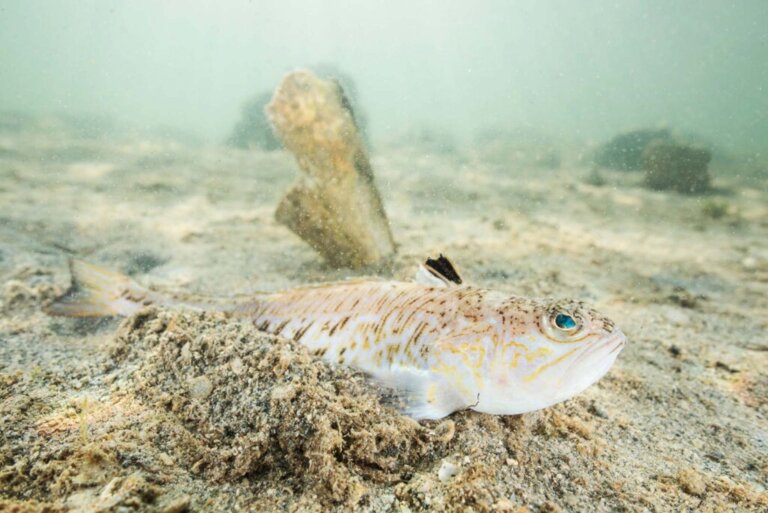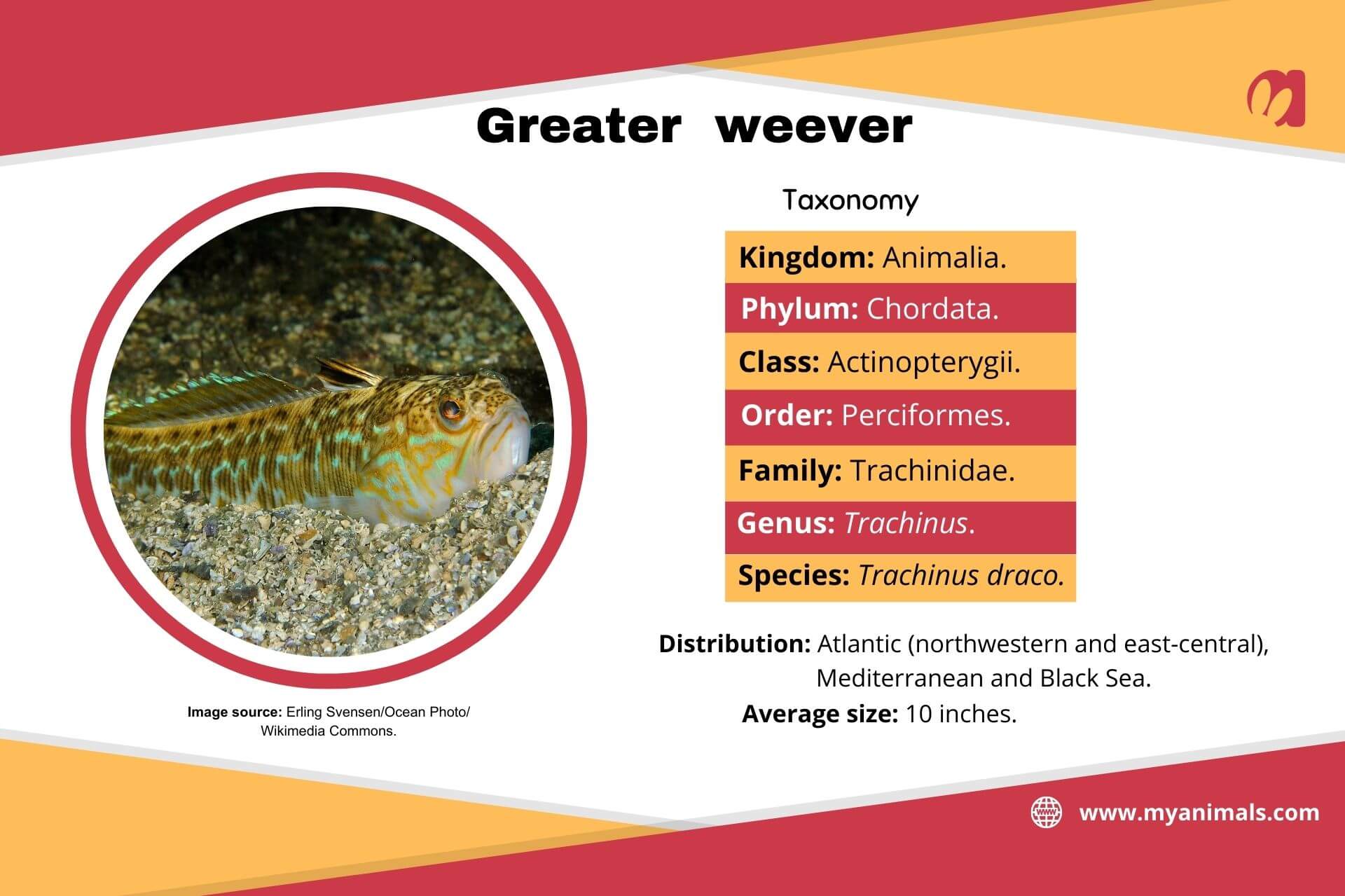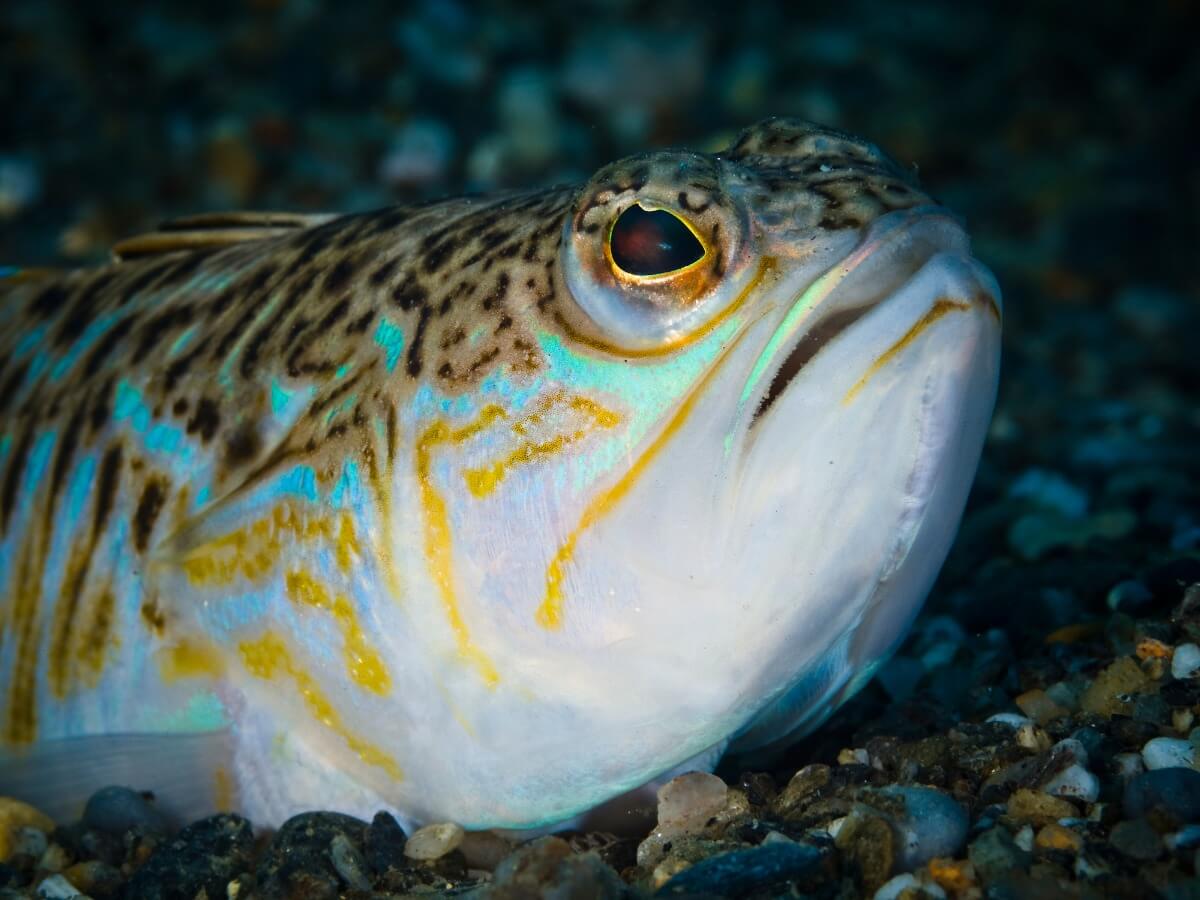The Greater Weever: How to Combat its Deadly Venom


Written and verified by the biologist Cesar Paul Gonzalez Gonzalez
The greater weever is a medically important marine species that has a potentially deadly venom. Of course, there are certain mitigating factors that can reduce the risks, so it’s always important to know how to handle these encounters in the most appropriate manner.
The scientific name of this species is Trachinus draco, and it belongs to the Perciform (perch-like) order of fish. It’s one of the most diverse and abundant groups of vertebrates in the world. Learn more about the greater weever’s sting in the following article.
General information about the greater weever

The greater weever belongs to the most diverse genus of the Trachinidae family (Trachinidae), which is composed of 8 species in total. Of these, Trachinus draco is the most common and abundant, according to a paper published in Zoologica Baetica.
The greater weever is an organism with strict benthic habits. This means that it lives close to the seabed at depths of no more than 300 meters.
It usually stays buried in the sandbanks near the coasts, which is the main reason for several unfortunate encounters with swimmers.
This species is distributed in a large part of the Atlantic. However, its presence is restricted to the coastlines. It can be found from Norway to Mauritania, including the Mediterranean, the Black Sea, and several island regions, such as Madeira and the Canary Islands.
Greater weevers have a slender, elongated appearance that widens toward the mouth. As mentioned by FishBase, their bodies average 25 centimeters (10 inches) in length, but can reach 40 centimeters (16 inches). In addition, their coloration pattern is restricted to light beige colorations with dark brown spots.
At the same time, the species has two pelvic fins, one caudal, and two dorsal fins. The latter are inconspicuous and have thickened rays, which are connected to venom glands that are released under pressure.

How potent is the venom of the greater weever?
The greater weever’s venom is composed of two main toxins: Trachykinin and dracotoxin. This is stated in an article published in the journal Toxicon: X. These molecules are also known as cytolysins and are characterized by causing cell lysis.
Therefore, their effects on humans vary according to the area and time of inoculation. A study published in Toxins (Basel) mentions that, in general, the greater weever’s venom has hemolytic and neurotoxic effects.
The lesions caused are very painful and the discomfort spreads over the area until it becomes unbearable. A clinical note published in Medifam specifies that the pain is often accompanied by the following symptoms:
- Nausea
- Sweating
- The sensation of loss of consciousness
Although these manifestations seem to indicate that the great weever’s sting isn’t dangerous, the situation may worsen if not treated promptly. In fact, it can lead to necrosis. In addition, a publication in The Journal of Laryngology & Otology, suggests that neck stings are always an emergency.
Due to all of the above, it’s crucial that you go to the nearest health center as soon as a bite occurs. Most cases will resolve quickly after treatment, but you should be very careful with lesions located on the head or in the abdominal area. This is because of the possibility of the toxins reaching vital organs – such as the heart – and becoming lethal.
The venom can be more or less toxic
The venom-secreting apparatus of the greater weever consists of two glands associated with each dorsal fin. According to a study published in the journal Acta Zoologica, these structures react differently to the temperature of the environment, which changes the structure and effectiveness of the toxins.
Despite this, it’s important to emphasize that the precise effect of temperature on spiderfish venom is still uncertain. As suggested by the above research, cold water may increase its toxicity. The toxins are considered to be thermolabile – heat-susceptible – and warm water is often used as the primary treatment for lesions.

How to treat a greater weever sting
According to an article published in the journal Toxicon:X – cited above – the common treatment for greater weever stings is to immerse the limb or area of injury in hot water (between 102 and 113 °F). If this is done for a period of 20 to 90 minutes, a progressive decrease in pain will be noted.
The above procedure only serves to “neutralize” the greater weever’s toxins. However, disinfection of the wound still needs to be performed in order to avoid secondary infections. This can be done directly at home, but it’s important that you go to a healthcare facility to ensure that it’s done correctly.
Depending on the severity of the lesion and the inoculation time, severe cases may require the removal of necrotic tissue from the wound.
This should be done by a healthcare professional to ensure the asepsis of the procedure. Also, the doctor may recommend the use of local anesthetics or anti-inflammatory drugs, for the following purposes:
- To reduce swelling
- To combat pain
- To control general discomfort
Antibiotics may also be recommended for a variable period of time. However, this indication is left to the decision of the professional.
What can you do if you’re bitten by a spider fish?
In any case, it’s mandatory to go as soon as possible to the nearest health center and report the type of fish that caused the injury. Of course, the latter isn’t always possible. So, prioritize getting to the doctor. If you’re likely to be delayed or are a long distance away, you can follow these tips:
- Clean and disinfect the injury (remove the remains of the thorns very carefully).
- Immerse the limb in hot water (between 102 and 113 °F) or apply heat with fomentation for at least 30 minutes.
Avoid using tourniquets or applying cold after these steps.
The above tips are only a provisional treatment, so it’s still urgent that you see a doctor. Remember that each case must be evaluated to avoid severe complications. So, if you’re bitten by one of these fish, prioritize your health and don’t be careless.
A painful sting, but easy to handle
As you can see, greater weever stings aren’t usually difficult to handle but they should be treated immediately to avoid aggravating the injury. In most cases, this episode will end up as nothing more than a bad memory. However, if it’s your turn to help a person, keep a close eye on the symptoms and return to the doctor if there’s still no improvement.
The greater weever is a medically important marine species that has a potentially deadly venom. Of course, there are certain mitigating factors that can reduce the risks, so it’s always important to know how to handle these encounters in the most appropriate manner.
The scientific name of this species is Trachinus draco, and it belongs to the Perciform (perch-like) order of fish. It’s one of the most diverse and abundant groups of vertebrates in the world. Learn more about the greater weever’s sting in the following article.
General information about the greater weever

The greater weever belongs to the most diverse genus of the Trachinidae family (Trachinidae), which is composed of 8 species in total. Of these, Trachinus draco is the most common and abundant, according to a paper published in Zoologica Baetica.
The greater weever is an organism with strict benthic habits. This means that it lives close to the seabed at depths of no more than 300 meters.
It usually stays buried in the sandbanks near the coasts, which is the main reason for several unfortunate encounters with swimmers.
This species is distributed in a large part of the Atlantic. However, its presence is restricted to the coastlines. It can be found from Norway to Mauritania, including the Mediterranean, the Black Sea, and several island regions, such as Madeira and the Canary Islands.
Greater weevers have a slender, elongated appearance that widens toward the mouth. As mentioned by FishBase, their bodies average 25 centimeters (10 inches) in length, but can reach 40 centimeters (16 inches). In addition, their coloration pattern is restricted to light beige colorations with dark brown spots.
At the same time, the species has two pelvic fins, one caudal, and two dorsal fins. The latter are inconspicuous and have thickened rays, which are connected to venom glands that are released under pressure.

How potent is the venom of the greater weever?
The greater weever’s venom is composed of two main toxins: Trachykinin and dracotoxin. This is stated in an article published in the journal Toxicon: X. These molecules are also known as cytolysins and are characterized by causing cell lysis.
Therefore, their effects on humans vary according to the area and time of inoculation. A study published in Toxins (Basel) mentions that, in general, the greater weever’s venom has hemolytic and neurotoxic effects.
The lesions caused are very painful and the discomfort spreads over the area until it becomes unbearable. A clinical note published in Medifam specifies that the pain is often accompanied by the following symptoms:
- Nausea
- Sweating
- The sensation of loss of consciousness
Although these manifestations seem to indicate that the great weever’s sting isn’t dangerous, the situation may worsen if not treated promptly. In fact, it can lead to necrosis. In addition, a publication in The Journal of Laryngology & Otology, suggests that neck stings are always an emergency.
Due to all of the above, it’s crucial that you go to the nearest health center as soon as a bite occurs. Most cases will resolve quickly after treatment, but you should be very careful with lesions located on the head or in the abdominal area. This is because of the possibility of the toxins reaching vital organs – such as the heart – and becoming lethal.
The venom can be more or less toxic
The venom-secreting apparatus of the greater weever consists of two glands associated with each dorsal fin. According to a study published in the journal Acta Zoologica, these structures react differently to the temperature of the environment, which changes the structure and effectiveness of the toxins.
Despite this, it’s important to emphasize that the precise effect of temperature on spiderfish venom is still uncertain. As suggested by the above research, cold water may increase its toxicity. The toxins are considered to be thermolabile – heat-susceptible – and warm water is often used as the primary treatment for lesions.

How to treat a greater weever sting
According to an article published in the journal Toxicon:X – cited above – the common treatment for greater weever stings is to immerse the limb or area of injury in hot water (between 102 and 113 °F). If this is done for a period of 20 to 90 minutes, a progressive decrease in pain will be noted.
The above procedure only serves to “neutralize” the greater weever’s toxins. However, disinfection of the wound still needs to be performed in order to avoid secondary infections. This can be done directly at home, but it’s important that you go to a healthcare facility to ensure that it’s done correctly.
Depending on the severity of the lesion and the inoculation time, severe cases may require the removal of necrotic tissue from the wound.
This should be done by a healthcare professional to ensure the asepsis of the procedure. Also, the doctor may recommend the use of local anesthetics or anti-inflammatory drugs, for the following purposes:
- To reduce swelling
- To combat pain
- To control general discomfort
Antibiotics may also be recommended for a variable period of time. However, this indication is left to the decision of the professional.
What can you do if you’re bitten by a spider fish?
In any case, it’s mandatory to go as soon as possible to the nearest health center and report the type of fish that caused the injury. Of course, the latter isn’t always possible. So, prioritize getting to the doctor. If you’re likely to be delayed or are a long distance away, you can follow these tips:
- Clean and disinfect the injury (remove the remains of the thorns very carefully).
- Immerse the limb in hot water (between 102 and 113 °F) or apply heat with fomentation for at least 30 minutes.
Avoid using tourniquets or applying cold after these steps.
The above tips are only a provisional treatment, so it’s still urgent that you see a doctor. Remember that each case must be evaluated to avoid severe complications. So, if you’re bitten by one of these fish, prioritize your health and don’t be careless.
A painful sting, but easy to handle
As you can see, greater weever stings aren’t usually difficult to handle but they should be treated immediately to avoid aggravating the injury. In most cases, this episode will end up as nothing more than a bad memory. However, if it’s your turn to help a person, keep a close eye on the symptoms and return to the doctor if there’s still no improvement.
All cited sources were thoroughly reviewed by our team to ensure their quality, reliability, currency, and validity. The bibliography of this article was considered reliable and of academic or scientific accuracy.
- Arantón-Areosa, L., Díaz, B. G., Rey, J. S. C., Prieto, J. M. R., Filgueiras, J. V., & Casal, M. J. C. (2008). Cicatrización de lesión secundaria a amputación de dedo índice por picadura de Pez Araña. Enfermería Dermatológica, 2(3), 28-33. https://dialnet.unirioja.es/servlet/articulo?codigo=4609991
- Bañón, R., GaRCía-FeRnández, C., Alonso-Fernández, A., Arronte, J. C., Baldó, F., Mariño, J. C., & Carlos, A. D. (2021). Enigmatic coloration pattern in greater weever Trachinus draco Linnaeus, 1758 and its biological significance. CYBIUM, 45(3), 205-208. https://digital.csic.es/handle/10261/261325
- Campos, F. V., Fiorotti, H. B., Coitinho, J. B., & Figueiredo, S. G. (2021). Fish cytolysins in all their complexity. Toxins, 13(12), 877. https://www.ncbi.nlm.nih.gov/pmc/articles/PMC8704401/
- Delibas, V., Ocar, G., Ugurlugulbuken, G., Guney, Z., Alagoz, S., Ozdas, T., & Kuran, G. (2023). How dangerous can a small fısh be? A greater weever attack. The Journal of Laryngology & Otology, 137(3), 350-353. https://pubmed.ncbi.nlm.nih.gov/35000640/
- Gorman, L. M., Judge, S. J., Fezai, M., Jemaà, M., Harris, J. B., & Caldwell, G. S. (2020). The venoms of the lesser (Echiichthys vipera) and greater (Trachinus draco) weever fish–A review. Toxicon: X, 6, 100025. https://www.sciencedirect.com/science/article/pii/S2590171020300035
- Lemus Reyes, J. N., & Boada Fernández del Campo, C. (2001). La picadura del pez araña. Medifam, 11(6), 62-69. https://scielo.isciii.es/scielo.php?pid=S1131-57682001000600006&script=sci_arttext&tlng=en
- Ministerio de Agricultura, Pesca y Alimentación. (s. f.). Guía de especies marinas desembarcadas en puertos españoles: Peces óseos. Consultado el 2 de junio de 2023. https://www.mapa.gob.es/es/ministerio/servicios/informacion/plataforma-de-conocimiento-para-el-medio-rural-y-pesquero/observatorio-de-buenas-practicas/buenas-practicas-sobre-alimentacion/guia-peces2.aspx
- Portillo Strempel, A., & Herrera Ceballos, E. (2014). Histology of the venom gland of T rachinus draco (A ctinopterygii, T rachinidae). Acta Zoologica, 95(2), 125-132. https://onlinelibrary.wiley.com/doi/abs/10.1111/azo.12004
- Strempel, A. P., Baró, J., Mancera, J. M., & Ceballos, E. H. (2008). Distribución espacial de Trachinus draco (Linnaeus, 1758),(Pesciforme, Trachinidae) en el norte del Mar de Alborán (España). Zoologica baetica, (19), 3-14. https://dialnet.unirioja.es/servlet/articulo?codigo=5413716
- Trachinus draco summary page. (s. f). FishBase. Consultado el 7 de junio de 2023. https://www.fishbase.se/summary/trachinus-draco.html
- Pez araña (Trachinus draco). (s. f.). Canal Mar Menor. Recuperado el 7 de junio de 2023. https://canalmarmenor.carm.es/inventario-ecologico/fauna/pez-aranatrachinus-draco/
This text is provided for informational purposes only and does not replace consultation with a professional. If in doubt, consult your specialist.








